Garden hose
A garden hose, hosepipe, or simply hose is a flexible tube used to convey water. There are a number of common attachments available for the end of the hose, such as sprayers and sprinklers (which are used to concentrate water at one point or to spread it over a large area). Hoses are usually attached to a hose spigot or tap.
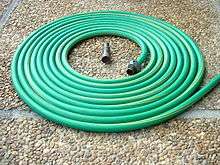
Terminology
The alternative term "hosepipe" is a chiefly British, South African, and southern US usage; "hose" or "garden hose" is the predominant term in other English-speaking areas. The term "hose" is also used for other types of flexible, water-carrying tubes such as those used by fire departments.
Description
Garden hoses are typically made of extruded synthetic rubber or soft plastic, often reinforced with an internal web of fibers. As a result of these materials, garden hoses are flexible and their smooth exterior facilitates pulling them past trees, posts and other obstacles. Garden hoses are also generally tough enough to survive scraping on rocks and being stepped on without damage or leaking.
Each male end of a typical garden hose can mate with the female connector on another, which allows multiple garden hoses to be linked end-to-end to increase their overall length. Small rubber or plastic washers (often confusingly called "hose washers") are used in female ends to prevent leakage, because the threads are not tapered and are not used to create a seal. Sometimes the gaskets stiffen, disintegrate, or fall out of older hoses, which results in pressurized leakage spraying from the hose; simply replacing the washer insert often fixes the problem.
Most garden hoses are not rated for use with hot water, and their packaging will often specify whether or not this is the case. Leaving non-reinforced hoses in the hot sun while pressurized can cause them to burst.
Hoses used to carry potable water are typically made of NSF International-listed polymers tested and shown not to leach harmful materials into the drinking water, such as the plasticizers (phthalates) used in polyvinyl chloride (PVC, or vinyl) hoses.
Use
As implied by the name, garden hoses are commonly used to transport water for gardening, lawn care, and other landscaping purposes. They are also used for outdoor cleaning of items such as vehicles, equipment, building exteriors, and animals. NSF-approved hoses may be used for connecting drinkable water to recreational vehicles and trailers.
Whenever a flexible hose is connected to a drinkable water supply, the spigot or tap should be fitted with an approved backflow prevention device, to prevent contaminated water from being siphoned back, in the event of a pressure drop. Many water suppliers require this, and plumbing code may legally require permanently installed backflow preventers.
Porous or perforated soaker hoses
Special hoses designed to leak throughout their length are sometimes used to gently distribute water on a lawn or garden. These hoses have either many small holes drilled or punched in them, or are deliberately made of a porous material, such as sintered rubber particles. These "soaker hoses"[1] are a simple, low-cost, substitute for a drip irrigation system.
Expandable hoses
These differ from traditional hoses in that the inner membrane expands when filled with water, much like a balloon. An outer cover protects the delicate expandable membrane from punctures. Such hoses "grow" when pressurized, and shrink back down when the pressure is released, allowing for easier storage.
Standards and connectors
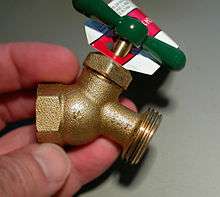
Garden hoses connect using a male/female thread connection. The technical term for this arrangement is a "hose union". Spigots or sillcocks have male hose connectors only, and the mating end of a hose has a captive nut which fits the threads there.
The thread standard for garden hose connectors in the United States, its territories, and Canada is known colloquially as "garden hose thread" (GHT), but its official designation is NH (NH stands for "National Hose"; 3⁄4-11.5NH is for full form threads as produced by cutting material such as the brass spigot outlet or hose male or female end fitting found on more expensive hoses; 3⁄4-11.5NHR is for thin-walled couplers produced by rolling thin material, usually brass, typically found on less expensive hoses; 3⁄4-14NPSH is for female hose ends that mate a hose to a tapered pipe thread without a spigot). The standard was defined by NFPA 1963, "Standard for Fire Hose Connections",[2] then later by ANSI-ASME B1.20.7,[3] which is 1 1⁄16 inches (27 mm) diameter straight (non-tapered) thread with a pitch of 11.5 threads per inch (TPI). The female thread is abbreviated FHT (for "female hose thread"), and the male part is abbreviated MHT (for "male hose thread"). This fitting is used with 1⁄2-inch, 5⁄8-inch, and 3⁄4-inch hoses.[4][5]
In other countries, a British Standard Pipe (BSP) thread is used, which is 3⁄4 inch (19 mm) and 14 TPI (male part outside diameter is 26.441 mm or 1.04 in). The GHT and BSP standards are not compatible, and attempting to connect a GHT hose to a BSP fitting, or vice versa, will damage the threads.
Various adaptors made of metal or plastic are available to interconnect GHT, BSP, NPT, hose barb, and quick connect fittings.
Quick connectors
Throughout the in the 1980s, the use of quick-connector systems has become increasingly popular. These are fittings that attach to the hose and or screw into common hose connectors and equipment, allowing hoses and accessories to be easily connected together using a snap-fit type system. The first plastic connector was invented in the UK by Hozelock in 1959[6] and the style has now become the de facto standard throughout Europe and the wider world, compatible with and imitated by many other manufacturers including German company Gardena who are popular in the United States and also make a large size 'Profi' system for high flow applications[7]. The connectors may optionally include an internal valve that is only opened by connecting the fitting, so that disconnecting a hose using this adaptor causes the water flow to stop. This greatly eases common tasks by allowing specialised sprayers to be interchanged without requiring adapters or spigot changes.
Health risks from aerosols
In 2014, it was reported that use of common garden hoses in combination with spray nozzles may generate aerosols containing droplets smaller than 10 μm, which can be inhaled by nearby people. Water stagnating in a hose between uses, especially when warmed by the sun, can host the growth and interaction of Legionella and free-living amoebae (FLA) as biofilms on the inner surface of the hose. Clinical cases of Legionnaires' disease or Pontiac fever have been found to be associated with inhalation of garden hose aerosols containing Legionella bacteria. The report provided measured microbial densities resulting from controlled hose conditions in order to quantify the human health risks. The densities of Legionella spp. identified in two types of hoses were found to be similar to those reported during legionellosis outbreaks from other causes. It was proposed that the risk could be mitigated by draining hoses after use.[8]
History
In the United States, the first garden hose spray nozzle, and thus possibly the first US threaded garden hose coupler, was made prior to 1890 by the W. D. Allen Mfg. Co. of Chicago, Illinois.
Gallery
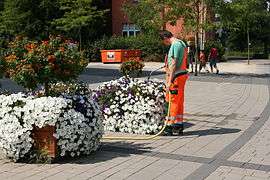 Garden hose in use (Germany)
Garden hose in use (Germany)- Closeup of a garden hose shows the crisscrossed fiber reinforcements
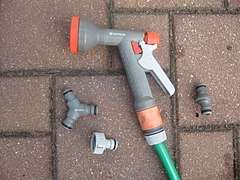 Gardena quick-connect hose fittings
Gardena quick-connect hose fittings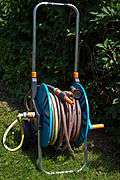 Hose cart and some quick-connect fittings
Hose cart and some quick-connect fittings- This greenhouse is equipped with a hose suspended on pulleys
.jpg) Special expandable hose can be stretched to reach farther
Special expandable hose can be stretched to reach farther
See also
| Wikimedia Commons has media related to Garden hoses. |
- Drip irrigation
- Fire hose
- Hose coupling
- Outdoor water-use restriction, or "hosepipe ban"
References
- Dave's Garden. Definition of soaker hose.
- "NH=National Hose". Ring & Plug Thread Gauges. Retrieved 26 August 2017.
- ASME B1.20.7-1991. "Hose Coupling Screw Threads (Inch)". Retrieved 26 August 2017.
- Bill Lauer (1 January 2004). AWWA Water Operator Field Guide. American Water Works Association. pp. 209–. ISBN 978-1-58321-315-5.
- Rolf Ekenes (19 January 2010). Southern Marine Engineering Desk Reference. Xlibris Corporation. pp. 134–. ISBN 978-1-4691-1637-2.
- https://www.hozelock.com/about-us/
- https://www.gardena.com/uk/products/watering/sprinklersystem/profi-maxi-flow-system-connector-set/900927901/
- Thomas, Jacqueline M.; Thomas, Torsten; Stuetz, Richard M.; Ashbolt, Nicholas J. (2014). "Your Garden Hose: A Potential Health Risk Due toLegionellaspp. Growth Facilitated by Free-Living Amoebae". Environmental Science & Technology. 48 (17): 10456–10464. doi:10.1021/es502652n. ISSN 0013-936X.